Alan Cathcart | June 28, 2018
Rebel With A Cause
Confederate Motors is dead, and in its place comes a new American manufacturer linking the past with the present, Curtiss Motorcycles
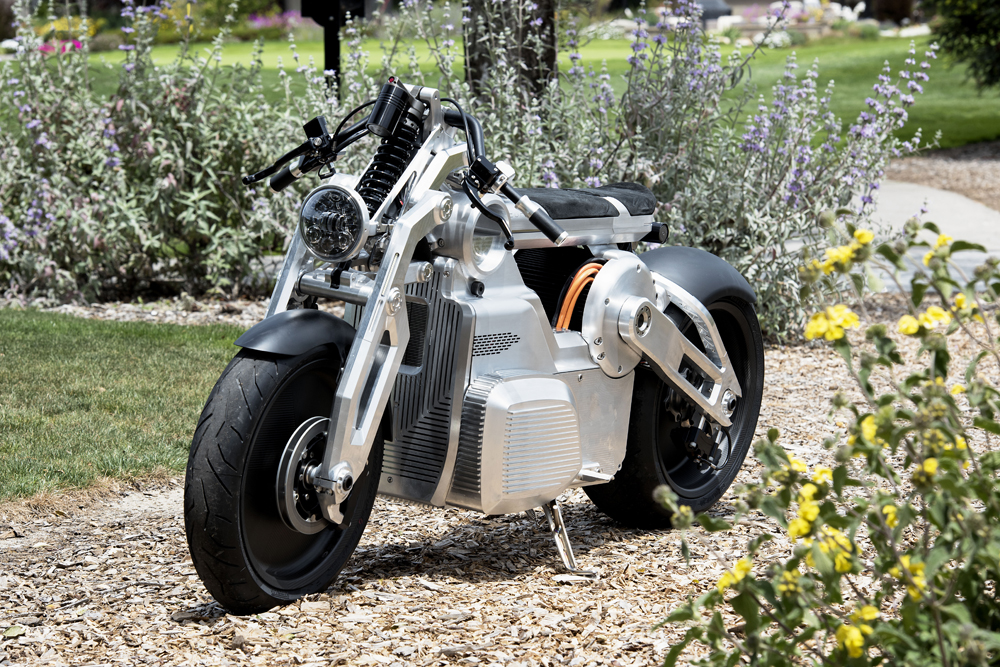 Machined beauty? Depends who you talk to, but the Curtiss Zeus is certainly unique.
Machined beauty? Depends who you talk to, but the Curtiss Zeus is certainly unique.
Cliché though it may be, it’s also self-evident that beauty lies in the eyes of a beholder—but even so, pretty much every entrant in the fast-growing street-legal EV marketplace has seemed, until now, to be a visual compromise at best, aesthetically challenged at worst.
Okay, the Isle of Man TT-winning MotoCzysz E-racer was fine art on two wheels, but in customer street-bike terms even the different variants of the Italian Energica, while undeniably easy on the eye, still attempt to visually gloss over the fact that they happen to be electric motorcycles. The combustion engine package and fuel tank which they and other such bikes would normally carry have been replaced by the array of batteries needed for any decent range, as well as the motor these power, and the controller that enables that.
Until now, E-bike designers have tried their best to hide these away in trying to produce a “normal-looking” motorcycle, with nobody daring to make a design feature out of the batteries themselves, or the motors. But that’s all changed with the advent of the new Curtiss Zeus launched in May at California’s prestigious Quail Motorcycle Gathering, whose judges selected it as the show’s Most Innovative Motorcycle, ahead of several other electric two-wheelers on display.
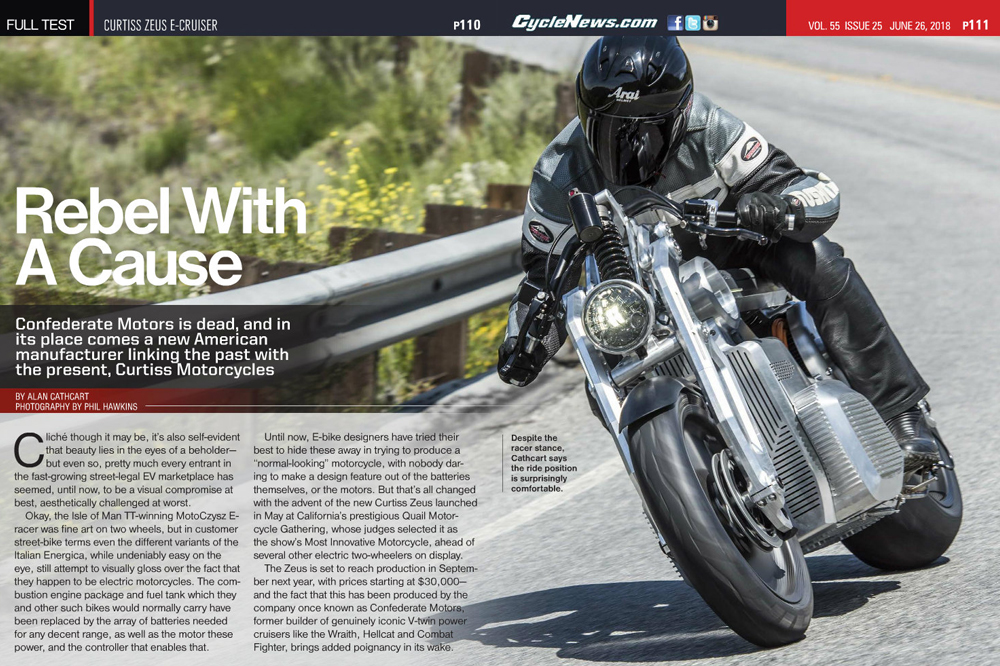
Click here to read this in the Cycle News Digital Edition Magazine.
Photography by Phil Hawkins
The Zeus is set to reach production in September next year, with prices starting at $30,000—and the fact that this has been produced by the company once known as Confederate Motors, former builder of genuinely iconic V-twin power cruisers like the Wraith, Hellcat and Combat Fighter, brings added poignancy in its wake.
For all good things must, indeed, come to an end, and after practicing the Art of Rebellion for a quarter of a century in altogether manufacturing 1300 outrageously unconventional, totally uncompromising V-twin maxi-cruisers since it was founded in Louisiana in 1992 by former trial lawyer Matt Chambers, Confederate has built its last such bike, thus marking an end to 25 years of iconoclastic innovation. For this maker of literally unique V-twin hardware has changed its name, in formally abandoning the use of internal combustion engines in its products. The company, which today, is based in Birmingham, Alabama, after being expelled from its former New Orleans home by Hurricane Katrina in 2005, and is still headed by Matt Chambers as President/CEO, has been renamed Curtiss Motorcycles after the legendary American motorcycling and aviation pioneer Glenn H. Curtiss. His most notable achievement on two wheels was to set a World Land Speed Record of 136.36 mph in January 1907 at Ormond Beach, Florida on a 40 bhp, 4410cc V8-powered motorcycle, which he’d designed and built himself, before thereafter transferring his attention to aircraft, and to emulating the feats of the Wright Brothers. His motorcycle speed record would stand for another 23 years before it was beaten.
But whereas Confederate’s various models have hitherto all featured muscular engines that were as loud in action as they looked to be at rest, the born-again Curtiss brand’s debut Zeus E-cruiser model is a Rebel with a Cause, which, in pursuit of combining zero-emission transportation with also looking cool, wafts along to the sound of silence while delivering an all-new look to the electric bike marketplace. It also breaks new ground in being powered by not one but two air-cooled, brushless, permanent-magnet 3-phase DC motors which offer a combined output of 170 bhp, linked together in a patented modular system with a single common output shaft, to potentially deliver massive torque and vivid acceleration. The Zeus is the kickoff model in a series of Curtiss E-motorcycles with varying levels of performance, and sticker prices starting at $20,000—a further contrast to Confederate’s previous status as the mucho expensivo brand of two-wheeled choice for America’s rich and famous, at prices up to $155,000. Serial celebrities ranging from Hollywood A-listers Tom Cruise, Brad Pitt and Nicholas Cage, through to rock idols Bruce Springsteen, Steven Tyler, and country music star Tim McGraw, are to be found in Confederate’s roster of high-profile owners, often with more than one of these exquisitely crafted and consequently costly two-wheeled works of art in their garages. Matt Chambers is hoping they’ll be equally ready to go green with Curtiss.
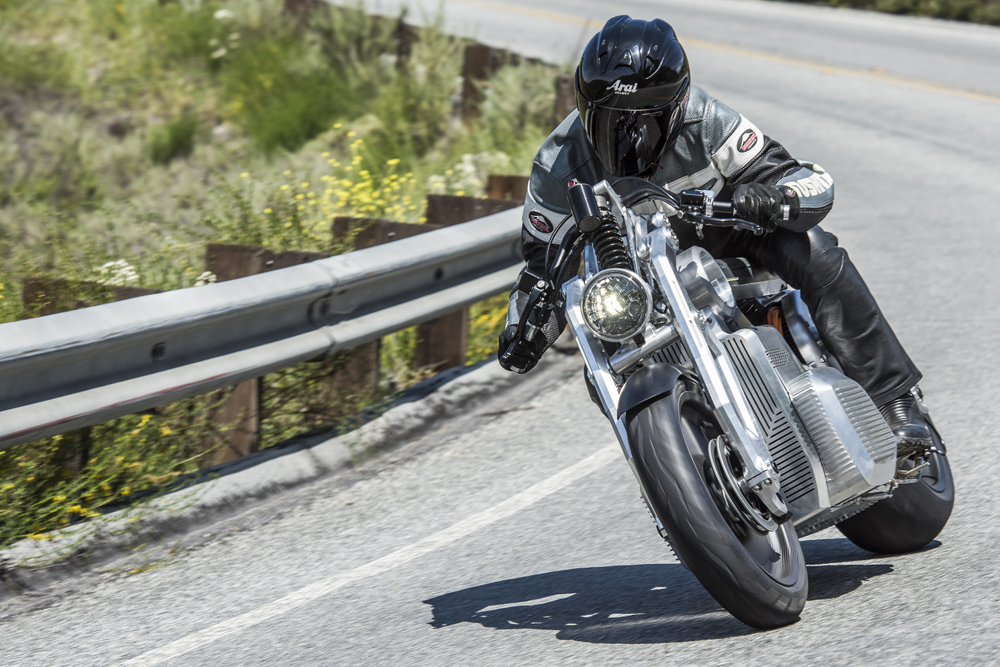 Despite the racer stance, Cathcart says the ride position is surprisingly comfortable.
Despite the racer stance, Cathcart says the ride position is surprisingly comfortable.
“Curtiss Motorcycles will focus on producing a range of electric-powered two-wheelers which will fit every pocketbook, with the Zeus as the prototype,” says Chambers. “The Curtiss models will deploy a modular architectural system, the design of which we’ve filed numerous patents on. Our all-new E-Twin powertrain and batteries will have superior weight management compared to any other two-wheeled EV. The geometry and ergonomics will be benchmark level, too, empowering the rider with effortless control, as well as massive acceleration, top speed, handling and comfort. Whole new levels of safety have been designed into the Zeus. We’re turning many pages here, and our mission is to future-proof the all-American hot rod.”
Chambers’ foresight in acquiring the Curtiss trademark seven years ago parallels the late Claudio Castiglioni’s purchase of the rights to the MV Agusta name six full years before restoring this legendary trophy brand to the motorcycle marketplace, with the advent of the Tamburini-designed F4. “We acquired the Curtiss name because of my admiration for the achievements of Mr. Curtiss, who was I believe a truly visionary person, and a great motorcyclist,” he states. “Glenn H. Curtiss was three years ahead of Indian in creating the American V-twin—which Indian then copied, just as Harley-Davidson did later. He was running 136 mph on a motorcycle when those guys were bragging about doing 50 or 60 mph, and then he got bored with the whole two-wheel thing, and went off and essentially created the modern aviation industry.
“But he was the one flying the planes, he invented the twist grip throttle, he designed the engines powering his aircraft, and it’s his rudder design, and all his technology that flies planes today, not anyone else’s. He was a very brave man, too, because he not only rode his own motorcycles at high speed on Ormond Beach, but he also flew the aircraft and seaplanes he’d invented. He was a man’s man.”
Okay, but why electric, and why electric and Curtiss together? “Because if Glenn Curtiss would show up today, I think his thirst for innovation and his genius for free-thinking would lead him to developing a unique take on the electric motorcycles that are unquestionably the future for personal transportation on two wheels, and that’s what we aim to provide with the products bearing his name.”
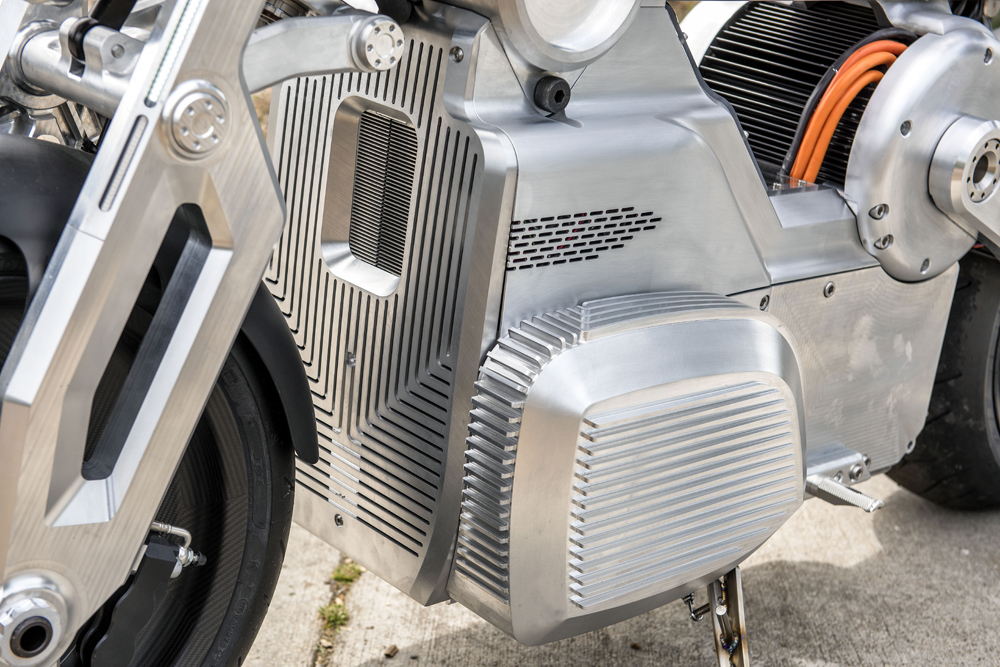 Curtiss’s youthful Design Director Jordan Cornille wanted to make the batteries a focal point of the design.
Curtiss’s youthful Design Director Jordan Cornille wanted to make the batteries a focal point of the design.
Chambers is targeting a 2020 model year production of 135 Curtiss E-motorcycles, and aims to be ready to start taking orders by the end of this year via the Curtiss Motorcycles website, with EPA approval and Euro 5 compliance (which will entail fitting ABS, currently absent from the prototype Zeus) scheduled for completion by July 2019. He envisages production ramping up to 400 motorcycles for the 2021 model year, before coming on stream with the less costly, higher volume, cast-alloy bikes.
“Our primary initial aim is to get California and the U.S. certified,” he says. “We believe California will be the most fertile market for Curtiss to begin with, and that, we can expand organically, once we get established there. But besides ABS I want to feature traction control on all our bikes, because of the significant torque that our E-Twin format will deliver. These are two important features without which I wouldn’t want to sell anyone a bike. But we’re going to move extremely fast, and put a lot of leverage on getting these motorcycles to market with these features.”
Thus the Zeus displayed at the Quail Gathering had only been finished four days earlier, then ridden literally around the block outside the Curtiss factory in Birmingham at around 40 mph tops, before being loaded in a van and driven for 50 hours from Alabama to Monterey, California, arriving the day before the show.
Under those circumstances, my promised exclusive first ride on the completely undeveloped bike the day after its prize-winning public debut seemed likely to be little more than a low-speed cruise around the streets of Carmel—and while I’m sure there’ll be many customers who won’t aim to ride their Zeus much harder than that, it seemed a bit of a waste. But hang on, let’s head inland to the Laurales Incline running between Salinas and Carmel Valley, and after twisting the wrist to make some motion, let gravity take over to give me speeds of 75 mph according to the camera car filming me, and a good test of how the Zeus will be to ride. Only this time around, predominantly powered by Isaac Newton.
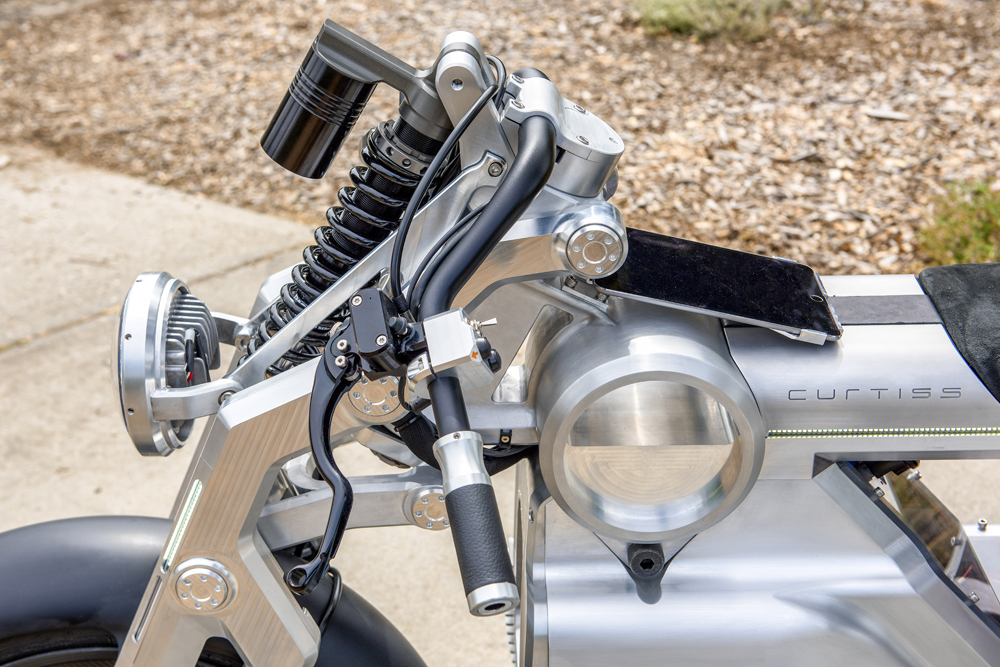 There’s more than a touch of the old Confederate design in the Curtiss Zeus.
There’s more than a touch of the old Confederate design in the Curtiss Zeus.
One look at the Zeus tells you which company built it, for the entire front-end is a reworking of the girder-type fork design of the kind to be found on the FA-13 Combat Bomber power cruiser, which brought Confederate production to an end.
But it’s a pretty comprehensive reworking by Jordan Cornille, with different geometry as well as quite a different structure, in the same way the Bomber’s fuselage containing the fuel tank has now been replaced by the low 30-inch Zeus seat. I have to admit I wasn’t looking forward much to straddling this, because it looked about as welcoming as a plank of wood. But it was practically shocking how comfortable the black suede covered padding was, and in 90 minutes of riding the Zeus I didn’t remotely get any numb-bum syndrome.
The footrests are adjustable back and forth over 1.25 inches—I had them in the midway slot, which was pretty comfortable, and there will be pillion footrests for a passenger, which hadn’t been fitted yet. But how about those handlebars—not very cruiser-esque, are they?! Turns out they’re fitted on this debut bike as a one-off tribute to Glenn Curtiss and his record-breaking exploits on the sands of Ormond Beach. Customers will have a choice of half a dozen different shapes and heights, though I again must admit that against all expectations, the super-dropped bars on the debut bike felt pretty good, and allowed me to tuck away nicely at high-ish speed.
 This is a guy on the move: Design Director Jordan Cornille in his office surrounded by sketches.
This is a guy on the move: Design Director Jordan Cornille in his office surrounded by sketches.
At such speeds the Curtiss handled the Laurales Incline’s sweeping turns and tighter S-bends brilliantly—no other word for it. For a start, the batteries are in the right place—nice and low—which means that coupled with its well-chosen steering geometry and the compliant suspension, the Zeus remained totally stable after hitting a bump cranked over at speed.
The girder front end and the cantilever rear are both equipped with Race Tech G3 monoshocks, fully-adjustable for high- and low-speed compression and rebound damping, and offering 4.95 inches wheel travel up front, and 5.25 inches at the rear. The way these shocks have been set up to give optimum damping and excellent ride quality was impressive, and I was especially impressed by the way the Zeus felt so taut and confidence inspiring in the way it steered, thanks doubtless to the new linear-rate ratio Jordan Cornille told me he’d dialed in to the front suspension link, together with Curtiss R&D engineer Tony Audette.
And the way those shocks handled the heavy 575-pound weight of the Zeus in prototype form (expect upwards of 50 pounds to be removed in production guise, says Jordan) was also good. With 17-inch Pirelli Diablo Rosso II rubber mounted on specially made BST carbon-fiber wheels, ground clearance wasn’t a problem, perhaps surprisingly with what seems to be a bulky motorcycle low down—although looking at the Zeus side-on, you can see that it rides quite high on the axles. The electric motors mounted either side of the swingarm pivot are lifted to give more space for battery storage under them, and the consequent steeply dropped swingarm is also a factor in delivering that ground clearance, in spite of the T-Block’s pseudo-Boxer format. When the E-Twin powertrain is properly dialed in, the significant weight transfer delivered by the huge amount of torque on tap will surely make the significant droop to the swingarm come into its own in combating this. Meanwhile, watching the upper link of the girder fork bobbing up and down before you is definitely addictive, and strangely reassuring!
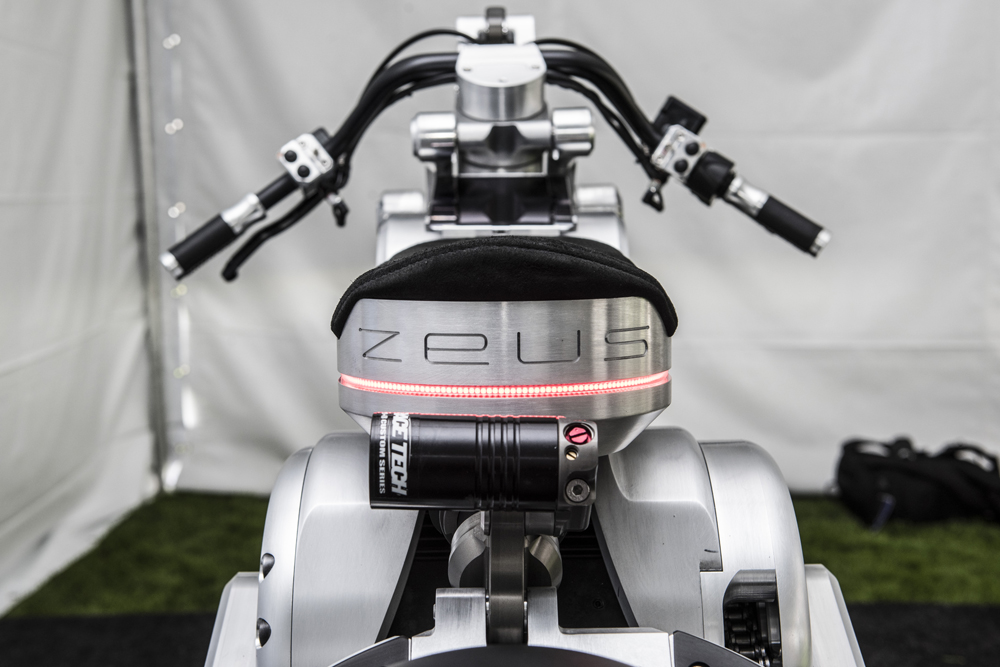 Race Tech supplied the suspension, which has been elegantly crafted into the overall design.
Race Tech supplied the suspension, which has been elegantly crafted into the overall design.
Proof that the front-end setup was dialed in came when I braked for a turn, and found the Zeus to be relatively agile—nimble, even, with the reduced gyroscopic effect of the BST carbon front wheel and downsized quartet of Beringer brakes helping speed up the steering, so that it switches direction from side to side pretty easily by E-bike standards, albeit quite lazily due to the long 58.25-inch wheelbase and conservative steering geometry, with a 27.5-degree rake to the machine-hewn girder fork.
But in spite of the dropped bars, this isn’t a sport bike, and I occasionally had a hard time remembering that. Its steering and handling are already dialed in, straight out of the box, with no need for the absent steering damper. That’s despite the fashion statement of a rear tire that’s been inflicted on the Zeus by the adoption of a massive 240/45-ZR17 Pirelli Diablo Rosso II, which didn’t heavy up the steering as much as I expected.
Obviously, I couldn’t make the same assessment at the rear, in terms of how well the Zeus will lay down the humongous torque available from those twin motors once these are functioning properly, but Curtiss have surely made a head start with their choice of tires and suspension settings. But the need for traction control will be overwhelming, and Matt Chambers is right to insist on this. However, he also must tell his R&D guys to dispense with the trendy iPad that doubles as a dash. Though not yet functional for obvious reasons, it will be completely illegible in bright sunlight, and easy pickings for thieves when you park up, unless you unclip it and carry it around with you. Too much of a good thing, it needs to be replaced by a fixed/permanent dash with every bit of data the rider could ever want to know displayed on it.
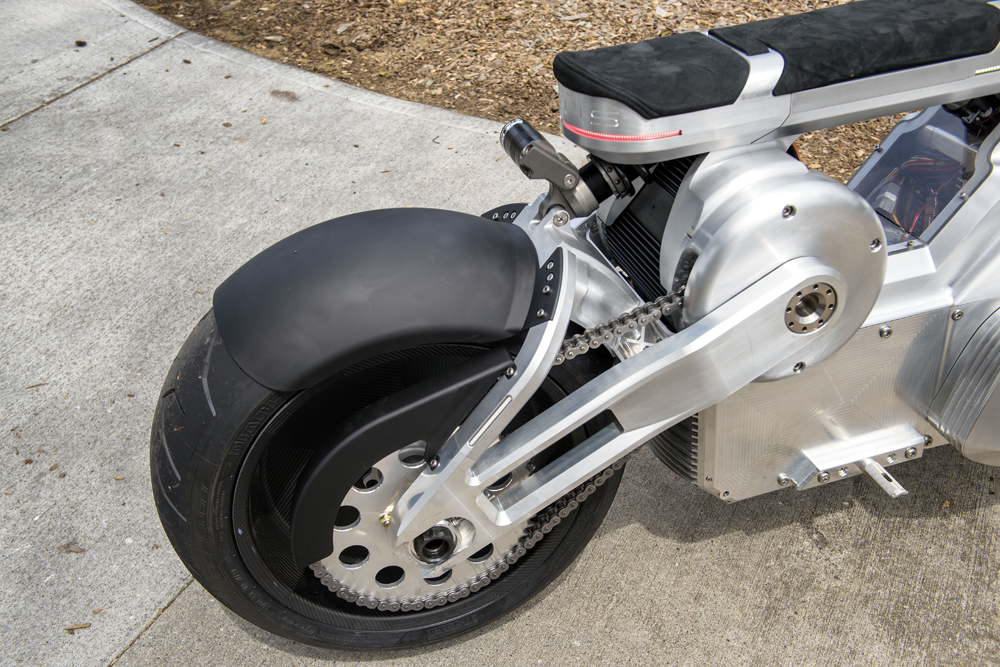 That massive tire is the same size as found on a Ducati Diavel.
That massive tire is the same size as found on a Ducati Diavel.
With such a heavy weight to stop, the 230mm Beringer Aeronal floating cast iron front discs that are doubled up on each side earn their keep, gripped by four-piston Beringer radially-mounted Aerotec calipers—though interestingly the Zeus weighs exactly the same as the Confederate Bomber they formerly equipped, but with a more desirable 53/47-percent weight distribution which helps load up the front wheel in turns.
These distinctive French brakes do an excellent job of stopping the Curtiss, with the rear-brake lever moved to replace the now absent clutch lever on the left handlebar. They aren’t as snatchy as they could be, a sign that Curtiss have used their years of experience in fitting these to all their models to get the choice of pads just right.
Jordan Cornille has reinvented the electric motorcycle with the Curtiss Zeus, and exclusively within the context of how it rides and handles, the result is dynamically satisfying, as well as visually arresting. Curtiss is off to a good start with this motorcycle, and it will be very interesting to see how it progresses once they get the electric powerplant properly dialed in.
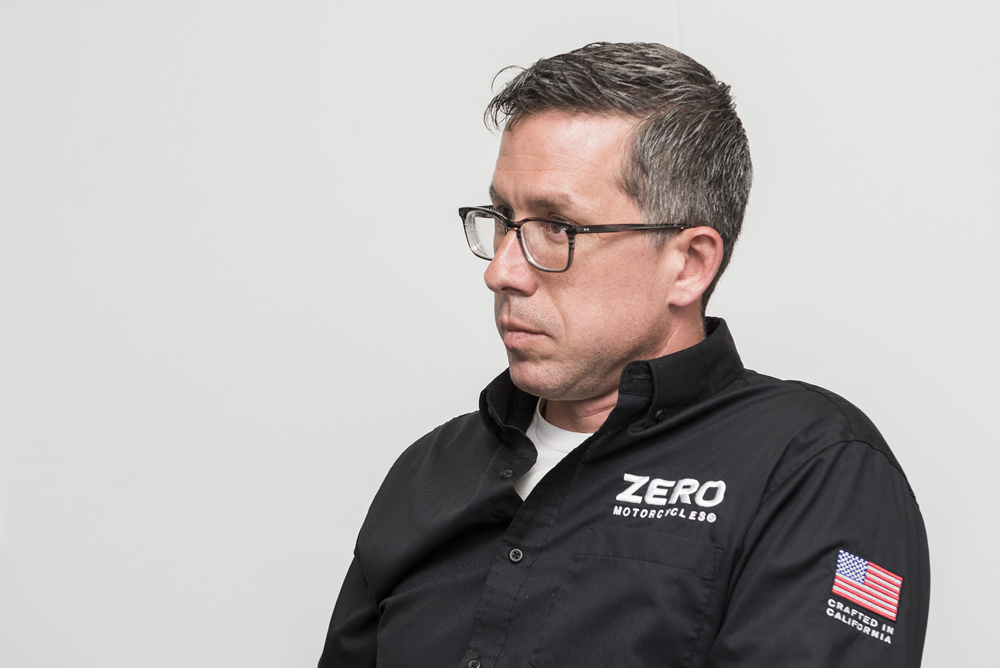 Sam Paschel, CEO of Zero Motorcycles, was not happy that the Curtiss design would use various powertrain parts from different suppliers.
Sam Paschel, CEO of Zero Motorcycles, was not happy that the Curtiss design would use various powertrain parts from different suppliers.
All Amounting To Zero
Curtiss engineers will have to establish a new set of electronic and powertrain suppliers, after initial plans to launch the Zeus with batteries, motors and a controller all supplied by Zero, the world’s number-one E-motorcycle manufacturer, came to naught exactly one month before the Quail launch of the Curtiss E-bike.
“We’d been working with the guys at Zero on the basis of a fixed agreement, and we were just finalizing our order for the Zeus powertrain kit, when they told us they were unable to work with the E-Twin format the way that we had it set up,” says Chambers. “Our design consists of two electric motors coupled together with a single output shaft, capable of putting out double the power and torque of a single motor. Our minimalist approach to design meant we couldn’t run two shafts, when one shaft can do the job. Zero had given us a thumbs-up on it, and we’d sent all our drawings to them, and ordered all the parts, which were to be made for this specific type of powertrain that had the two motors on a single crank. But then right at the end of the trail, just as our parts were coming in, and we had already assembled the motor packages, around 30 days before launching the Zeus at Quail we got word from Zero that we could not do that.”
It’s a tribute to Chambers’ perseverance and the determination of the Curtiss R&D team that they didn’t let this devastating blow divert them from being present at the Quail with an E-motorcycle in functioning order. “At first I was very hurt, and sad, that this should happen,” says Chambers. “But then I realized it was much better to find this out now before pre-selling one hundred of these bikes, and… then what? It was very beautiful to watch the Curtiss team in action the next day, after we all woke up ready to fight back. What we’ve discovered is something that I indeed imagined all along, and that is that there are very many smart young men dedicating themselves to this new EV technology. This is a very fertile field, and the technology is moving on very fast. I don’t doubt we’ll end up with a much better package at much better pricing, by just managing the situation ourselves in our newly formed Curtiss Advanced Powertrain Technology Division.
“Since getting kissed off by Zero, we’ve uncovered several battery suppliers, and a couple of controller companies with programmers, as well as sourcing the motors the way we wanted them from a supplier in Wisconsin. I don’t think we’ll have any problems without Zero—quite the reverse, in fact. There are many excellent suppliers that are dying to work with us, that love the idea of being teamed up with Curtiss. So right now, I’d say the Curtiss electric powertrain is going to be the very best, just like everything else we do.”
Sam Paschel, CEO of Zero Motorcycles, explains the reason for his company’s pullback decision. “Curtiss is an incredibly well respected brand, and I think they made a beautiful motorcycle. But although we sold them a powertrain, for us at Zero to feel comfortable with any powertrain customer, they have to use all of our components exclusively in that powertrain. It isn’t about picking controllers and batteries from here, and a harness from there, and a motor from someone else; it’s a package. That’s because we’ve now spent almost 12 years doing this, and our powertrain has a unified system, so we don’t piece things out. I think on the timeline that Curtiss wanted to hit, they needed to use non-Zero components in a couple of places to put the motorcycle together. And that’s a no-no for us.”
But was the essential disagreement between the two companies, indeed, that Curtiss wanted to have a single shaft joining two motors together, whereas Zero wanted to have two separate motors, each driving the rear wheel independently? “Yes—correct. The intent was always that we’d use two motors to drive the rear wheel, and we’re familiar with that configuration. But when push came to shove, with the timing they had, you couldn’t make that work without some different non-Zero components. So that’s why we declined to be involved further – but we still wish them the best.”
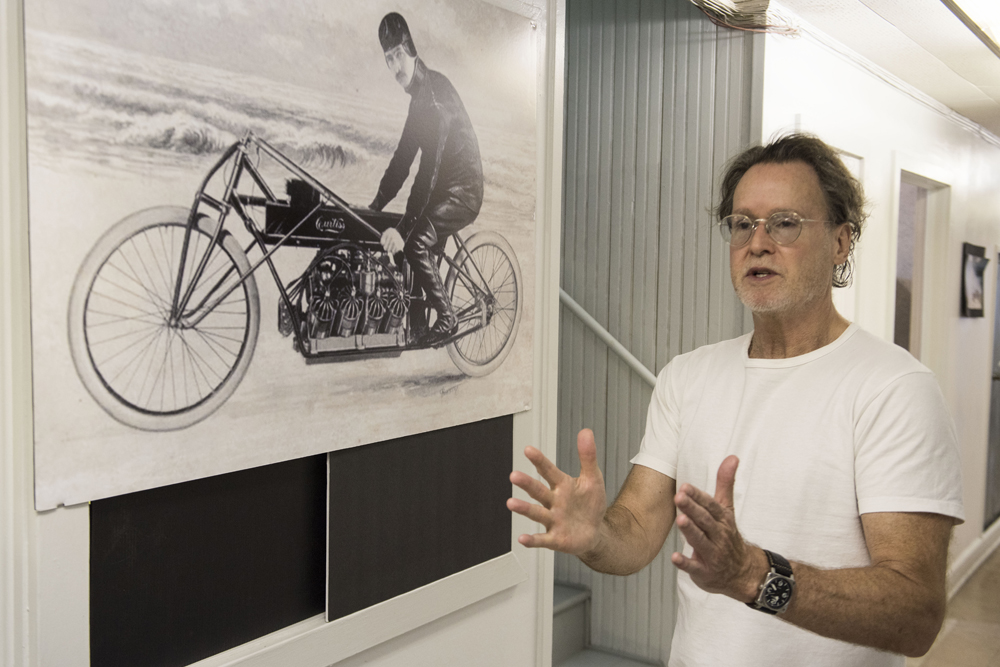 Curtiss CEO Matt Chambers in front of a depiction of Glenn H. Curtiss at Ormond Beach, FL, where he rode his 40 bhp, 4410cc V8-powered motorcycle to a World Land Speed Record of 136.36 mph in January 1907.
Curtiss CEO Matt Chambers in front of a depiction of Glenn H. Curtiss at Ormond Beach, FL, where he rode his 40 bhp, 4410cc V8-powered motorcycle to a World Land Speed Record of 136.36 mph in January 1907.
The Tech Side
In being created by Curtiss’s youthful Design Director, Jordan Cornille, 25, the Zeus turns traditional motorcycle design and styling on its head, by attempting to redefine the look and design of an E-bike in making the batteries the focal point of the motorcycle. Its 14.4kWh lithium-ion battery pack is carried in a milled-from-solid aluminum housing in what’s known as an inverted T-Block format, designed to hint at the layout of a conventional Boxer engine. In fact, Curtiss is planning a total of five platforms: three based on a twin-battery pack format, with the T-Block joined by a V-Block and P-Block (for the aptly named Porcupine!), and two different single-battery configurations—a Slant Block and a Vertical Block.
Chambers reveals that these two singles will be known as the Eros and the Hades, while, besides the Zeus, the other two twin-battery bikes will be the Medusa V-Block and the Hercules—the latter the name under which Glenn Curtiss sold his own bikes, which Chambers has just managed to reclaim after a lengthy process.
These and the Zeus will eventually be available as series production 2022 models at a target price of $30,000 each, but those versions will use a cast-aluminum monocoque frame-cum-battery container, and with a lower level of performance than the higher-priced billet aluminum models built to individual order. Curtiss plans to commence deliveries of these in September next year, and a carbon-fiber-framed version will also be available. It’s intended that the cast-frame singles will retail for $20,000 each, within the same time frame. That’s about double the $10,495 price of a 2018 Zero FXS ZF7.2, with the Zeus and its sisters likewise priced at around twice the current $16,495 of a Zero DSR ZF14.4. But all will have twin motors, insists Chambers, so they’ll have up to twice the performance, though presumably, also half the range, which is likely to require extra real estate to be found on the Zeus and its kin, for additional batteries. CN
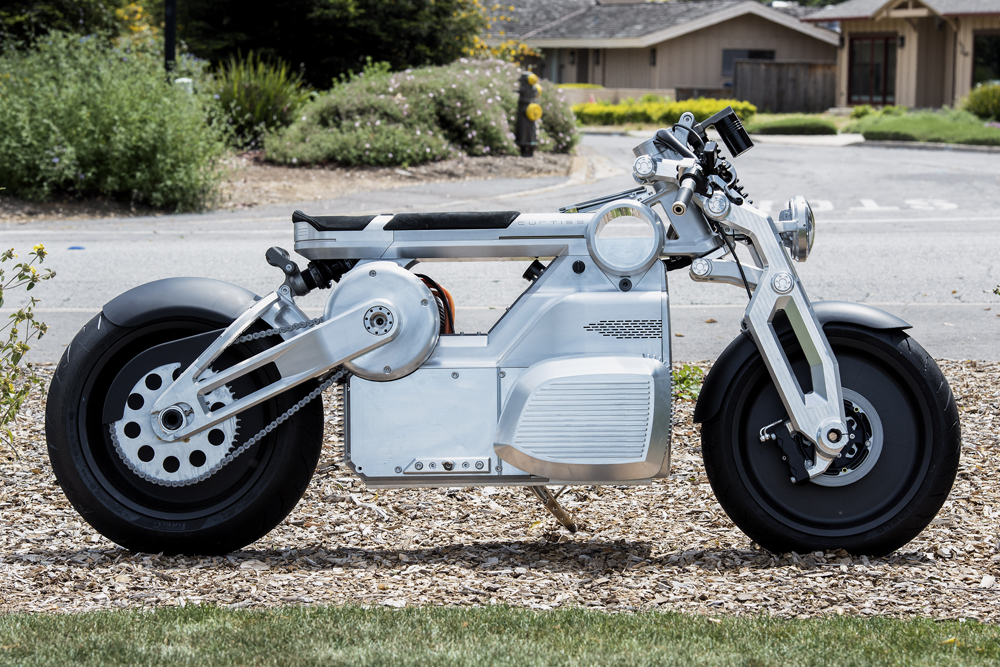
SPECIFICATIONS
|
Curtiss Zeus
|
| Motor: |
E-Twin format with 2 x electric, air-cooled, brushless, permanent-magnet 3-phase DC motors coupled together via a single output shaft |
| Max power: |
170 hp at 8000 rpm |
| Max torque: |
290 lb-ft at 1 rpm |
| Chassis: |
Machined modular aluminum monocoque |
| Front suspension: |
Double-wishbone parallelogram fork with tubular aluminum struts and linear-rate Race Tech G3 monoshock, fully adjustable for high- and low-speed compression and rebound damping |
| Rear suspension: |
Fabricated aluminum swingarm with cantilever Race Tech G3 monoshock offering two-speed compression and rebound damping |
| Front wheel travel: |
4.95 in. |
| Rear wheel travel: |
5.25 in. |
| Front brake: |
230mm Beringer floating Aeronal cast iron discs with 4-piston Beringer radially mounted Aerotec calipers |
| Rear brake: |
240mm cross-drilled Aeronal stainless steel disc with 2-piston Beringer caliper |
| Front tire: |
120/70ZR17 Pirelli Diablo Rosso II on 3.50 in. BST carbon wheel |
| Rear tire: |
240/45ZR17 Pirelli Diablo Rosso II on 8.50 in. BST carbon wheel |
| Wheelbase: |
58.25 in. |
| Seat height: |
30 in. |
| Weight (curb, claimed): |
575 lbs. |